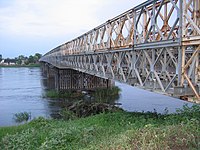
Photo from wikipedia
Eumycetoma is a chronic debilitating fungal disease endemic to tropical and subtropical regions, with Sudan featuring the highest eumycetoma incidence. Among the 50 species of fungi most commonly associated with… Click to show full abstract
Eumycetoma is a chronic debilitating fungal disease endemic to tropical and subtropical regions, with Sudan featuring the highest eumycetoma incidence. Among the 50 species of fungi most commonly associated with eumycetoma Madurella mycetomatis (M. mycetomatis) is often referenced as the most common pathogen. However, there is an enormous knowledge gap related to this neglected disease and its pathogenesis, epidemiological features, and host-specific factors that could contribute to either the host susceptibility and resistance. In this study, we were able to utilize a metagenomic approach and samples collected from clinical black grains (BG) and familiar household environments aimed to assay both the habitat of eumycetoma-associated fungi and its possible connection with eumycetoma patients living in two different eumycetoma endemic villages within the White Nile State of Sudan. DNA sequencing targeting the fungal ITS2 domain was performed on soil, animal dung, housing walls and roofs, and Acacia-species thorn samples and compared with culture-dependent methods of fungal isolation. Additionally, we compared the soil samples obtained in the endemic zone with that from non-endemic zones, including Wagga village in Kassala State and Port Sudan suburb in Port Sudan State. Overall, a total of 392 Amplicon Sequence Variants (ASVs) were detected by ITS2 metagenomics Eumycetoma causative organisms accounted for 10% of total ASVs which included 11 genera: Exserohilum (2%), Aspergillus (1.7%), Curvularia (1%), Alternaria (0.9%), Madurella (0.5%), Fusarium (0.4%), Cladosporium (0.2%) Exophiala (0.15%), and, in a lesser extent, Microascus (0.05%) Bipolaris and Acremonium (0.01%) for each. Only five genera were identified by culture method, which included Fusarium (29%), Aspergillus (28%), Alternaria (2.5%), Bipolaris (1.6%), and Chaetomium (0.8%). M. mycetomatis was detected within all the studied patients’ houses, accounting for 0.7% of total sequences. It was the first common eumycetoma-associated agent detected in soil samples and the third common in the dung and wall samples. In contrast, it was not detected in the roof or thorn samples nor in the soils from non-endemic regions. Exserohilum rostratum, Aspergillus spp and Cladosporium spp were detected in all samples. M. mycetomatis and other eumycetoma-associated fungal identified in the patients’ black grains (BG) samples by metagenomics were identified in the environmental samples. Only Acremonium alternatum and Falciformispora senegalensis, responsible for eumycetoma in two patients were not detected, suggesting the infections in these patients happened outside these endemic areas. The soil, animal dung, and houses built from the same soil and dung are the main risk factors for M. mycetomatis infection in these endemic villages. Furthermore, the poor hygienic and environmental conditions, walking barefooted, and the presence of animals within the houses increase the risk of M. mycetomatis and other fungi causing eumycetoma.
Journal Title: PLoS Neglected Tropical Diseases
Year Published: 2022
Link to full text (if available)
Share on Social Media: Sign Up to like & get
recommendations!